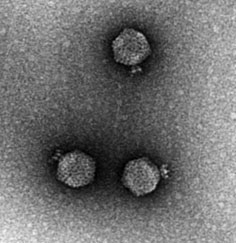|
Phageome
A phageome is a community of bacteriophages and their metagenomes localized in a particular environment, similar to a microbiome. The term was first used in an article by Modi ''et al'' in 2013 and has continued to be used in scientific articles that relate to bacteriophages and their metagenomes. A bacteriophage, or phage for short, is a virus that has the ability to infect bacteria and archaea, and can replicate inside of them. Phageome is a subcategory of virome, which is all of the viruses that are associated with a host or environment. Phages make up the majority of most viromes and are currently understood as being the most abundant organism. Oftentimes scientists will look only at a phageome instead of a virome while conducting research. In humans Although bacteriophages do not have the capability to infect human cells, they are found in abundance in the human virome. The human gut phageome has recently become a topic of interest in the scientific community. The mak ... [...More Info...] [...Related Items...] OR: [Wikipedia] [Google] [Baidu] |
Phage
A bacteriophage (), also known informally as a ''phage'' (), is a duplodnaviria virus that infects and replicates within bacteria and archaea. The term was derived from "bacteria" and the Greek φαγεῖν ('), meaning "to devour". Bacteriophages are composed of proteins that encapsulate a DNA or RNA genome, and may have structures that are either simple or elaborate. Their genomes may encode as few as four genes (e.g. MS2) and as many as hundreds of genes. Phages replicate within the bacterium following the injection of their genome into its cytoplasm. Bacteriophages are among the most common and diverse entities in the biosphere. Bacteriophages are ubiquitous viruses, found wherever bacteria exist. It is estimated there are more than 1031 bacteriophages on the planet, more than every other organism on Earth, including bacteria, combined. Viruses are the most abundant biological entity in the water column of the world's oceans, and the second largest component of biomass ... [...More Info...] [...Related Items...] OR: [Wikipedia] [Google] [Baidu] |
Bacteriophage
A bacteriophage (), also known informally as a ''phage'' (), is a duplodnaviria virus that infects and replicates within bacteria and archaea. The term was derived from "bacteria" and the Greek φαγεῖν ('), meaning "to devour". Bacteriophages are composed of proteins that encapsulate a DNA or RNA genome, and may have structures that are either simple or elaborate. Their genomes may encode as few as four genes (e.g. MS2) and as many as hundreds of genes. Phages replicate within the bacterium following the injection of their genome into its cytoplasm. Bacteriophages are among the most common and diverse entities in the biosphere. Bacteriophages are ubiquitous viruses, found wherever bacteria exist. It is estimated there are more than 1031 bacteriophages on the planet, more than every other organism on Earth, including bacteria, combined. Viruses are the most abundant biological entity in the water column of the world's oceans, and the second largest component of biom ... [...More Info...] [...Related Items...] OR: [Wikipedia] [Google] [Baidu] |
Bacteriophages
A bacteriophage (), also known informally as a ''phage'' (), is a duplodnaviria virus that infects and replicates within bacteria and archaea. The term was derived from "bacteria" and the Greek φαγεῖν ('), meaning "to devour". Bacteriophages are composed of proteins that encapsulate a DNA or RNA genome, and may have structures that are either simple or elaborate. Their genomes may encode as few as four genes (e.g. MS2) and as many as hundreds of genes. Phages replicate within the bacterium following the injection of their genome into its cytoplasm. Bacteriophages are among the most common and diverse entities in the biosphere. Bacteriophages are ubiquitous viruses, found wherever bacteria exist. It is estimated there are more than 1031 bacteriophages on the planet, more than every other organism on Earth, including bacteria, combined. Viruses are the most abundant biological entity in the water column of the world's oceans, and the second largest component of biomass ... [...More Info...] [...Related Items...] OR: [Wikipedia] [Google] [Baidu] |
Microbiome
A microbiome () is the community of microorganisms that can usually be found living together in any given habitat. It was defined more precisely in 1988 by Whipps ''et al.'' as "a characteristic microbial community occupying a reasonably well-defined habitat which has distinct physio-chemical properties. The term thus not only refers to the microorganisms involved but also encompasses their theatre of activity". In 2020, an international panel of experts published the outcome of their discussions on the definition of the microbiome. They proposed a definition of the microbiome based on a revival of the "compact, clear, and comprehensive description of the term" as originally provided by Whipps ''et al.'', but supplemented with two explanatory paragraphs. The first explanatory paragraph pronounces the dynamic character of the microbiome, and the second explanatory paragraph clearly separates the term ''microbiota'' from the term ''microbiome''. The microbiota consists of all ... [...More Info...] [...Related Items...] OR: [Wikipedia] [Google] [Baidu] |
Virome
Virome refers to the assemblage of viruses that is often investigated and described by metagenomic sequencing of viral nucleic acids that are found associated with a particular ecosystem, organism or holobiont. The word is frequently used to describe environmental viral shotgun metagenomes. Viruses, including bacteriophages, are found in all environments, and studies of the virome have provided insights into nutrient cycling, development of immunity, and a major source of genes through lysogenic conversion. History The first comprehensive studies of viromes were by shotgun community sequencing, which is frequently referred to as metagenomics. In the 2000s, the Rohwer lab sequenced viromes from seawater, marine sediments, adult human stool, infant human stool, soil, and blood. This group also performed the first RNA virome with collaborators from the Genomic Institute of Singapore. From these early works, it was concluded that most of the genomic diversity is contained in the gl ... [...More Info...] [...Related Items...] OR: [Wikipedia] [Google] [Baidu] |
Human Virome
The human virome is the total collection of viruses in and on the human body. Viruses in the human body may infect both human cells and other microbes such as bacteria (as with bacteriophages). Some viruses cause disease, while others may be asymptomatic. Certain viruses are also integrated into the human genome as proviruses or endogenous viral elements. Viruses evolve rapidly and hence the human virome changes constantly. Every human being has a unique virome with a unique balance of species. Lifestyle, age, geographic location, and even the season of the year can affect an individual's exposure to viruses, and one's susceptibility to any disease that might be caused by those viruses is also affected by pre-existing immunity and both viral and human genetics. The human virome is far from being completely explored and new viruses are discovered frequently. Unlike the roughly 40 trillion bacteria in a typical human microbiome, an estimate of the number of viral particles in a he ... [...More Info...] [...Related Items...] OR: [Wikipedia] [Google] [Baidu] |
Virosphere
Virosphere (virus diversity, virus world, global virosphere) is the viral part of the biosphere, namely the pool of viruses in all hosts and all environments on planet earth. Virosphere may also refer to a pool of certain group of viruses according to their host - prokaryotic virosphere, archaeal virosphere, Invertebrate virosphere, type of genome - RNA virosphere, dsDNA virosphere or ecological niche - marine virosphere Viral genome diversity The scope of viral genome diversity is enormous compared to cellular life. Cellular life including all known organisms have double stranded DNA genome. Whereas viruses have one of at least 7 different types of genetic information, namely dsDNA, ssDNA, dsRNA, ssRNA+, ssRNA-, ssRNA-RT, dsDNA-RT. Each type of genetic information has its specific manner of mRNA synthesis. Baltimore classification is a system providing overview on these mechanisms for each type of genome. Moreover, in contrast to cellular organisms, viruses don't have uni ... [...More Info...] [...Related Items...] OR: [Wikipedia] [Google] [Baidu] |
Microbiology
Microbiology () is the scientific study of microorganisms, those being unicellular (single cell), multicellular (cell colony), or acellular (lacking cells). Microbiology encompasses numerous sub-disciplines including virology, bacteriology, protistology, mycology, immunology, and parasitology. Eukaryotic microorganisms possess membrane-bound organelles and include fungi and protists, whereas prokaryotic organisms—all of which are microorganisms—are conventionally classified as lacking membrane-bound organelles and include Bacteria and Archaea. Microbiologists traditionally relied on culture, staining, and microscopy. However, less than 1% of the microorganisms present in common environments can be cultured in isolation using current means. Microbiologists often rely on molecular biology tools such as DNA sequence based identification, for example the 16S rRNA gene sequence used for bacteria identification. Viruses have been variably classified as organisms, as they have ... [...More Info...] [...Related Items...] OR: [Wikipedia] [Google] [Baidu] |
Biology
Biology is the scientific study of life. It is a natural science with a broad scope but has several unifying themes that tie it together as a single, coherent field. For instance, all organisms are made up of cells that process hereditary information encoded in genes, which can be transmitted to future generations. Another major theme is evolution, which explains the unity and diversity of life. Energy processing is also important to life as it allows organisms to move, grow, and reproduce. Finally, all organisms are able to regulate their own internal environments. Biologists are able to study life at multiple levels of organization, from the molecular biology of a cell to the anatomy and physiology of plants and animals, and evolution of populations.Based on definition from: Hence, there are multiple subdisciplines within biology, each defined by the nature of their research questions and the tools that they use. Like other scientists, biologists use the sc ... [...More Info...] [...Related Items...] OR: [Wikipedia] [Google] [Baidu] |
Wikipedia Student Program
Wikipedia is a multilingual free online encyclopedia written and maintained by a community of volunteers, known as Wikipedians, through open collaboration and using a wiki-based editing system. Wikipedia is the largest and most-read reference work in history. It is consistently one of the 10 most popular websites ranked by Similarweb and formerly Alexa; Wikipedia was ranked the 5th most popular site in the world. It is hosted by the Wikimedia Foundation, an American non-profit organization funded mainly through donations. Wikipedia was launched by Jimmy Wales and Larry Sanger on January 15, 2001. Sanger coined its name as a blend of ''wiki'' and ''encyclopedia''. Wales was influenced by the "spontaneous order" ideas associated with Friedrich Hayek and the Austrian School of economics after being exposed to these ideas by the libertarian economist Mark Thornton. Initially available only in English, versions in other languages were quickly developed. Its combined editions com ... [...More Info...] [...Related Items...] OR: [Wikipedia] [Google] [Baidu] |







